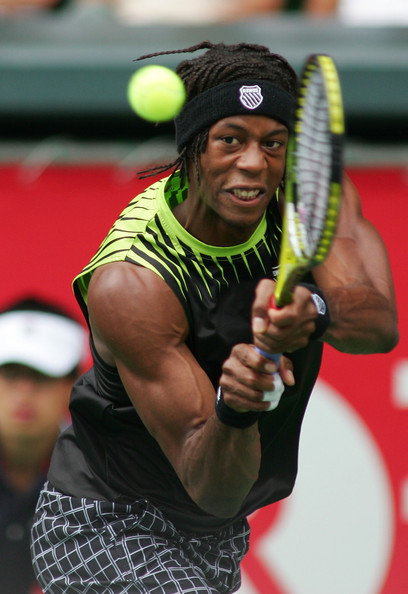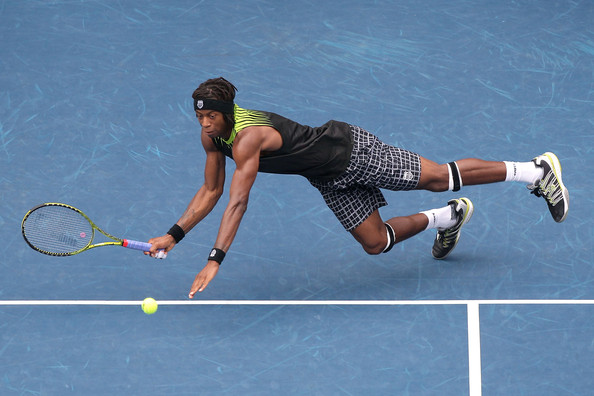Tokyo Open, Final
Nadal d. Monfils, 6/1 7/5
 The thought occurred to me, whilst watching Rafael Nadal wallop Gael Monfils earlier, that maybe we over-analyse why tennis matches are won or lost, or why certain players do the things they do. We concoct elaborate and fantastical psychologies to explain why a break point was played this way and not that. A graphic of second serve placement gets flashed up on the screen, and we immediately adduce an overarching strategy, as though each dot was a gun emplacement at Austerlitz.
The thought occurred to me, whilst watching Rafael Nadal wallop Gael Monfils earlier, that maybe we over-analyse why tennis matches are won or lost, or why certain players do the things they do. We concoct elaborate and fantastical psychologies to explain why a break point was played this way and not that. A graphic of second serve placement gets flashed up on the screen, and we immediately adduce an overarching strategy, as though each dot was a gun emplacement at Austerlitz.
Perhaps it’s all much simpler. Perhaps some tennis players just aren’t very bright. When you think about it, underlying all of our analysis is the tacit assumption that all players are basically moderately intelligent, capable of not only grasping a winning strategy, but of applying it and sticking to it. Perhaps we assume too much.
Every time Nadal smoked another forehand winner up the line (his fearsome shot du jour, or semaine), I’d holler through my screen at the improbably lithe French dude up the other end, “Go to his backhand!†Every time an emphysemic Nadal backhand sputtered and croaked its way to the service line, I’d roar it louder. “His backhand! For the Love of God, go to his backhand!†Using my tremendous physic powers, I projected ten-foot neon letters onto the back hoarding: “Stay away from Nadal’s forehand!” The writing was on the wall, figuratively and telepathically. Sadly, having little French, the writing was in English.
Now, it’s possible to overwhelm Nadal’s forehand on a hardcourt by hitting through it, rushing it by going deep, flat and very hard. Viktor Troicki showed us some of this in the semifinal. But it can’t be done from where Monfils was lurking, deep at the back of the court near the writing on the wall. (Perhaps he was trying to lose himself in the crowd, though I can’t imagine the crowd that Monfils might successfully hide in.) Conceivably, this was a strategy designed to negate Nadal’s vicious topspin, since the ball was generally on its way down by the time it got to the Frenchman. This seemed unlikely for several reasons:
- Monfils is tall enough to get over the spin, especially with his double-fisted backhand;
- The Tokyo court wasn’t bouncing all that high;
- This would imply that Monfils was employing any strategy at all.
Perhaps I’m being unfair, and Monfils was drawing inspiration from Nadal’s improbable loss to Guillermo Garcia-Lopez in Bangkok last week. Perhaps the ‘strategy’ – and the term is being used so loosely it may well be dislocated – was to drop the first set quickly, then hope the Spaniard blew 24 break points in the second. It would be like the Rumble in Jungle, and which Ali allowed Foreman to grow exhausted from punching him so much.
 It is sometimes remarked that being Monfils’ coach would be the world’s most frustrating job. That may be true, but again, perhaps we’re assuming too much. Maybe it was Roger Rasheed’s masterplan to feed balls up the middle of the court, at three quarter pace, all day. After all, playing within himself and inviting attack keeps Monfils in the top 20. Paradoxically, desperate retrieving from all parts of the court seems to be his percentage play. It’s gained him a cult following and sees him feature on countless highlight reels. But for every recovery from a seemingly hopeless position, there are the uncounted errors from actually hopeless positions. And the thing about percentages is that while they’ll wear down the hoi polloi, they won’t impress the big boys. Nadal’s forehand is to percentages what a howitzer is to passive smoking.
It is sometimes remarked that being Monfils’ coach would be the world’s most frustrating job. That may be true, but again, perhaps we’re assuming too much. Maybe it was Roger Rasheed’s masterplan to feed balls up the middle of the court, at three quarter pace, all day. After all, playing within himself and inviting attack keeps Monfils in the top 20. Paradoxically, desperate retrieving from all parts of the court seems to be his percentage play. It’s gained him a cult following and sees him feature on countless highlight reels. But for every recovery from a seemingly hopeless position, there are the uncounted errors from actually hopeless positions. And the thing about percentages is that while they’ll wear down the hoi polloi, they won’t impress the big boys. Nadal’s forehand is to percentages what a howitzer is to passive smoking.
To beat Nadal on clay you need a miracle. To beat him on a hardcourt, however, you need a plan, with the skill and willingness to execute it perfectly. And you also need the intelligence to adapt when it all inevitably goes south. It’s somewhere in that chain of requirements that Monfils gets lost. Is that all too complicated? I’ll make it simple: Go to his backhand. It’s not rocket surgery.
Commentary gem of the week, courtesy of Jason Goodall: “It’s deja vu all over again!” Pure Yogi Berra.
